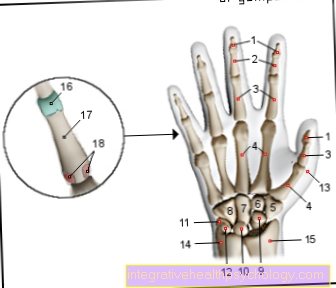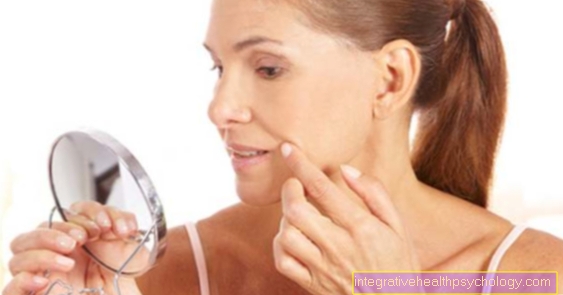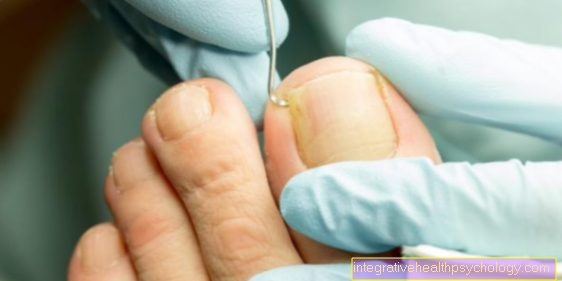Eye drops for an allergy
introduction
Allergies such as hay fever are often associated with bothersome symptoms in the eye area.
Itching and watery red eyes can significantly affect everyday life. Hence, there are different eye drop preparations that lead to one Relief from these ailments can contribute. They contain various anti-allergic agents. Most of them are available from pharmacies without a prescription.

These active ingredients help against the allergy
Various groups of active ingredients are used in the form of eye drops to treat allergic symptoms in the eye.
- A typical group of active ingredients are the so-called mast cell stabilizers. In the case of an allergy, so-called mast cells are activated in the body through activation of the immune system. This leads to the release of messenger substances such as histamine, which leads to the triggering of the typical allergic symptoms. Medicines from the group of mast cell stabilizers prevent the activation of mast cells and thus significantly reduce the release of histamine and other messenger substances. A typical drug of this group is Cromoglicic acid. The active ingredient is widely used in the form of eye drops and nasal drops for antiallergic treatment. For example, preparations available without a prescription in pharmacies that contain cromoglicic acid or substances similar to the substance are Vividrin ® eye drops, CromoHexal ® eye drops or Cromo Ratiopharm ® eye drops.
- Antihistamines are another common group of active ingredients used to treat allergic symptoms in the eyes. They bind to histamine receptors and thus reduce the histamine effect. Typical active ingredients that are contained in eye drops are, for example Azelastine, ketotifen, or levocabastine. As eye drop preparations containing antihistamines are exemplary Vividrin akut ®, Azela-Vision ®, Pollival ®, Zaditen ® and Livocab ® eye drops to call.
- Eye drops containing cortisone are used less often to treat allergic eye symptoms. For example, they contain the active ingredient Dexamethasone. The preparation is an example here Dexapos ® called.
You might also be interested in: Eye drops for dry eyes
This is how eye drops work with an allergy
The mechanism of action of the eye drops differs depending on which active ingredient is contained in the eye drops. What they all have in common is that they reduce the allergic symptoms in the eye.
Active ingredients such as cromoglicic acid work by stabilizing mast cells. So they inhibit the release of histamine from the mast cells active in the allergic reaction. Since histamine is the main messenger substance in the allergy cascade, this leads to a significant alleviation of allergy symptoms.
Active ingredients from the group of antihistamines such as levocabastine or azelastine work by inhibiting the effect of histamine on certain histamine receptors. The histamine released from mast cells in the course of the allergic reaction can no longer bind sufficiently to its receptors. As a result, histamine cannot develop its allergic effect sufficiently, so the allergic symptoms are significantly fewer.
Eye drops containing cortisone have an anti-inflammatory effect on the eye via various mechanisms and thus also quickly alleviate the allergic symptoms.
You can get an overview here: Eye drops and eye ointments
These eye drops with cortisone exist
Eye drops containing cortisone are used rather cautiously for the treatment of allergic complaints. This is due, among other things, to the fact that cortisone preparations can cause numerous side effects when used over a long period of time. There are also numerous other preparations available for the treatment of allergic symptoms in the eye that are better tolerated.
Eye drops containing cortisone are therefore only used in most cases in the case of pronounced allergic symptoms that cannot be adequately treated with preparations that do not contain cortisone. Possible active ingredients are dexamethasone and prednisolone. The preparations are exemplary here Inflanefran forte ®, Pred Forte ®, Dexapos ® and Isoptodex ® called.
Learn more about the topic at: Eye drops containing cortisone
Are there eye drops with cortisone without a prescription?
No. Eye drops containing cortisone all require a prescription or a prescription.
This is not least due to the fact that it should only be used in the event of severe allergic symptoms and that certain contraindications (contraindications), such as the presence of a glaucoma, must be observed. It should also only be used for a limited period of time.
Also read our article: Side effects of cortisone
These prescription eye drops are there
Most antiallergic eye drops are available from pharmacies without a prescription. Only eye drops that contain cortisone require a prescription in the form of a prescription. This has to do with the possible side effects, the contraindications to be observed and the time limit for use.
Antiallergic eye drops that contain active ingredients from the group of antihistamines or mast cell stabilizers, on the other hand, can usually be bought in pharmacies without a prescription.
also read: These drugs help with an allergy
Risks and side effects of eye drops for an allergy
The eye drops available without a prescription have relatively few side effects. Eye drops containing cromoglicinic acid can cause stinging of the eyes and a foreign body sensation. Eye drops that contain antihistamines also occasionally cause the mentioned irritation symptoms in the eye.
The preparation should also be mentioned here Zaditen ®, which is the antihistamine Ketotifen contains. In addition to the aforementioned irritation to the eye, the use of Zaditen ® Add eye drops according to the package insert dry eyes, blurred vision, increased sensitivity to light, conjunctival bleeding, corneal inflammation and corneal damage to lead. Systemic side effects, i.e. those affecting the whole body, are less common. Zaditen ® can here too a headache, sleepiness, Dry mouth such as skin rash to lead.
Eye drops that contain cortisone derivatives like Prednisolone or Dexamethasone also lead to potential side effects, particularly locally. These include the cortisone-containing eye drops:
- dry eyes
- inflamed eyes
- a discoloration of the cornea
- increased sensitivity to light
- blurred vision
- increased tears in the eyes
- Eye pain
- Itching around the eyes
- Foreign body sensation
- Burn
- Eye irritation and redness
- viral or bacterial eye infections
- Corneal ulcers (corneal ulcer)
- Decreased visual acuity or difficulty focusing
- Drooping eyelid (ptosis)
- Dilated pupil
- Lens opacity
- Disorders of taste sensation
- Increase in intraocular pressure
The latter is the reason why patients with a known glaucoma (glaucoma), i.e. increased intraocular pressure, must not use eye drops containing cortisone.
More information can be found here: Side effects of cortisone
That's how long I can use eye drops against an allergy
The duration of use of the eye drops available without a prescription is usually not limited. Some providers indicate an unlimited duration of use, other providers recommend that the application should not be longer than 6 weeks without medical advice.
The situation is different with eye drops containing cortisone: if the eye drops are used for more than 10 days, regular controls of the cornea and intraocular pressure are recommended. An application of more than 2 weeks is usually not recommended without renewed medical consultation and therapy consideration.
Eye drops in single drops or from the bottle?
Many of the above-mentioned antiallergic eye drops are optionally available as larger bottles or in so-called single-dose ophtiols. A pack usually contains 5 to 30 such single doses.
They only contain a few drops and are usually intended for single use. This means that a single dose ophthalmic product actually has to be used immediately after use. This has to do with the fact that there are no preservatives in the small bottles. The preservatives, which must be contained in normal-sized bottles, serve, among other things, to protect against germs. However, their effectiveness diminishes over time.
The advantage of single-dose ophtiols is therefore particularly given when the drops do not necessarily have to be used daily - for example in people with hay fever who do not suffer from eye symptoms every day, but only occasionally. If necessary, you can use the small ophtiols again after a longer period of time without these having already expired. But be careful: There is also an expiration date for single doses that must be observed.
The normal-sized eye drop bottles, on the other hand, are more suitable for patients who regularly (daily) suffer from eye symptoms over a certain seasonal period. Once the full-size bottle has been opened, the preservatives it contains mean that it will usually last about 4-6 weeks. The exact shelf life is listed in the package insert and should be observed.
Homeopathic eye drops
In addition to the above-mentioned conventional medical active ingredients, homeopathic medicine also offers options for treating allergic symptoms in the area of the eyes.
In particular, a preparation that is available in the form of eye drops is used here: We are talking about Euphrasia Eye drop. They are available both in the form of a full-size bottle and in the form of individual-dose packs of various sizes. They contain the herbal remedy Euphrasia (eyebright).
Euphrasis eye drops should be placed in both eyes 1-2 times a day. They should both have an anti-inflammatory effect and be soothing when the eyes are overstrained, for example through excessive screen work. Side effects are not known.
More on this: Euphrasia eye drops - how do they work?
Recommendations from our editorial team
- Nasal spray for an allergy
- Therapy for an allergy
- Desensitization for hay fever
- Allergy on the face
- These drugs help if you have an allergy





























